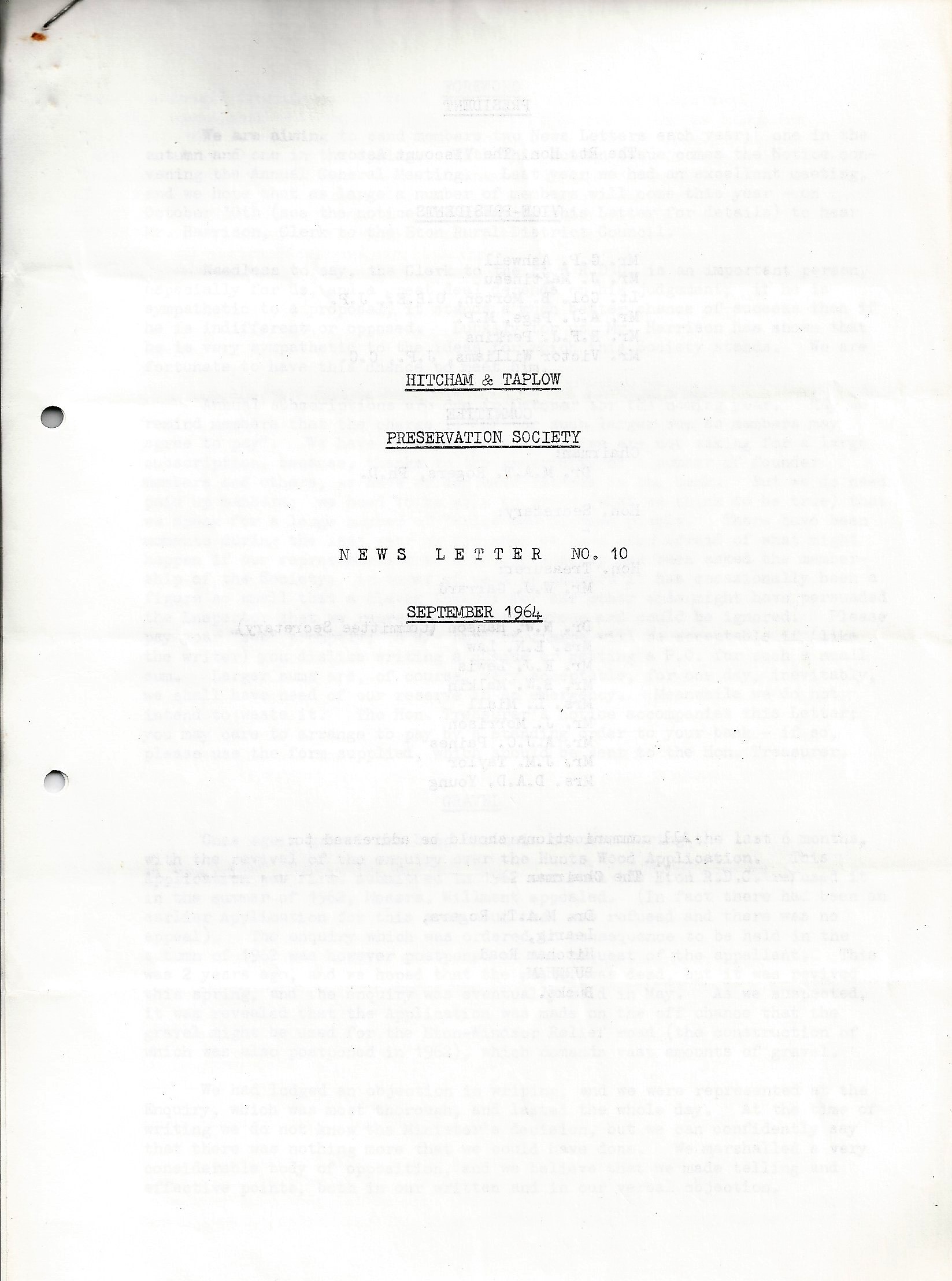
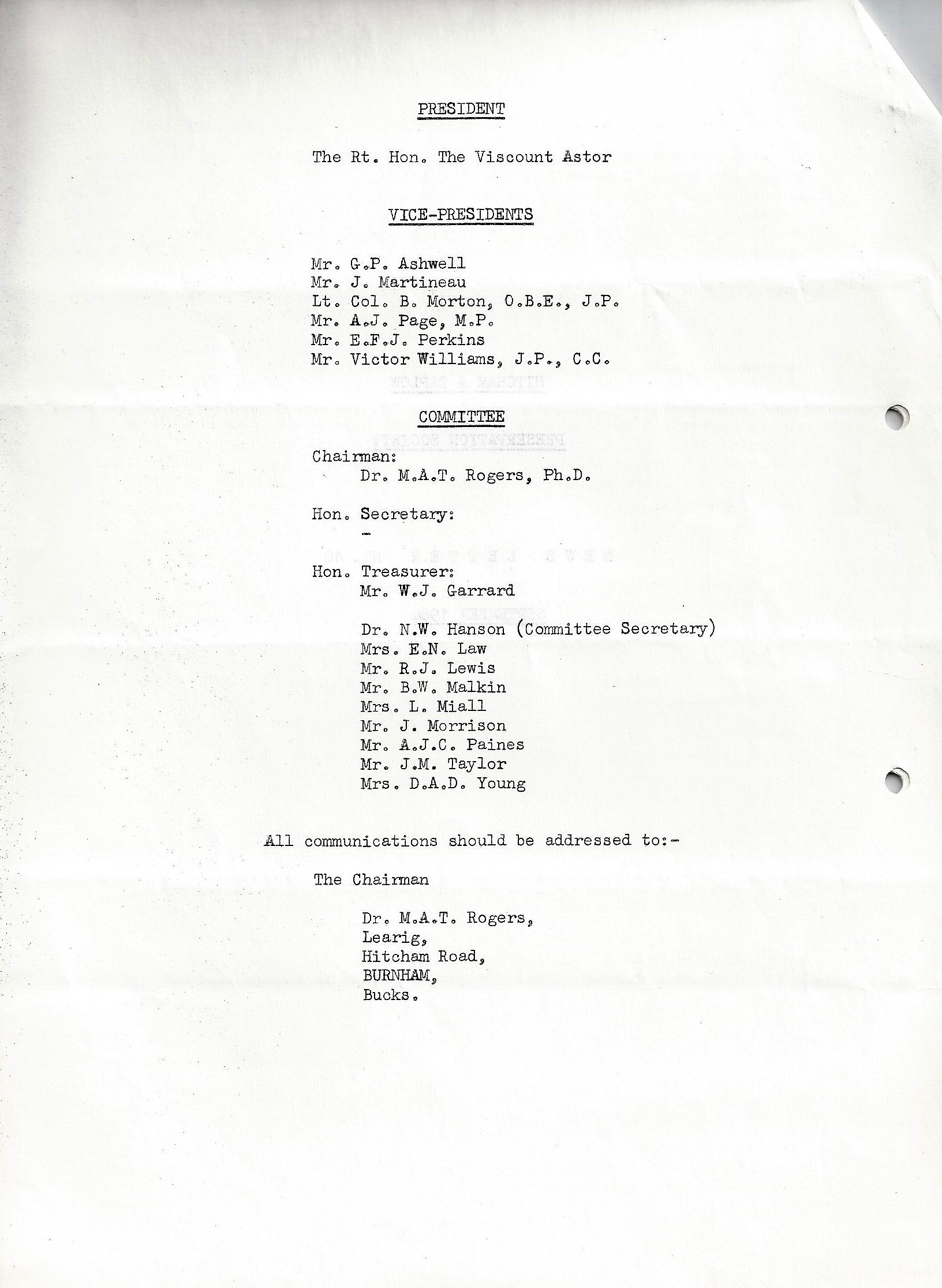
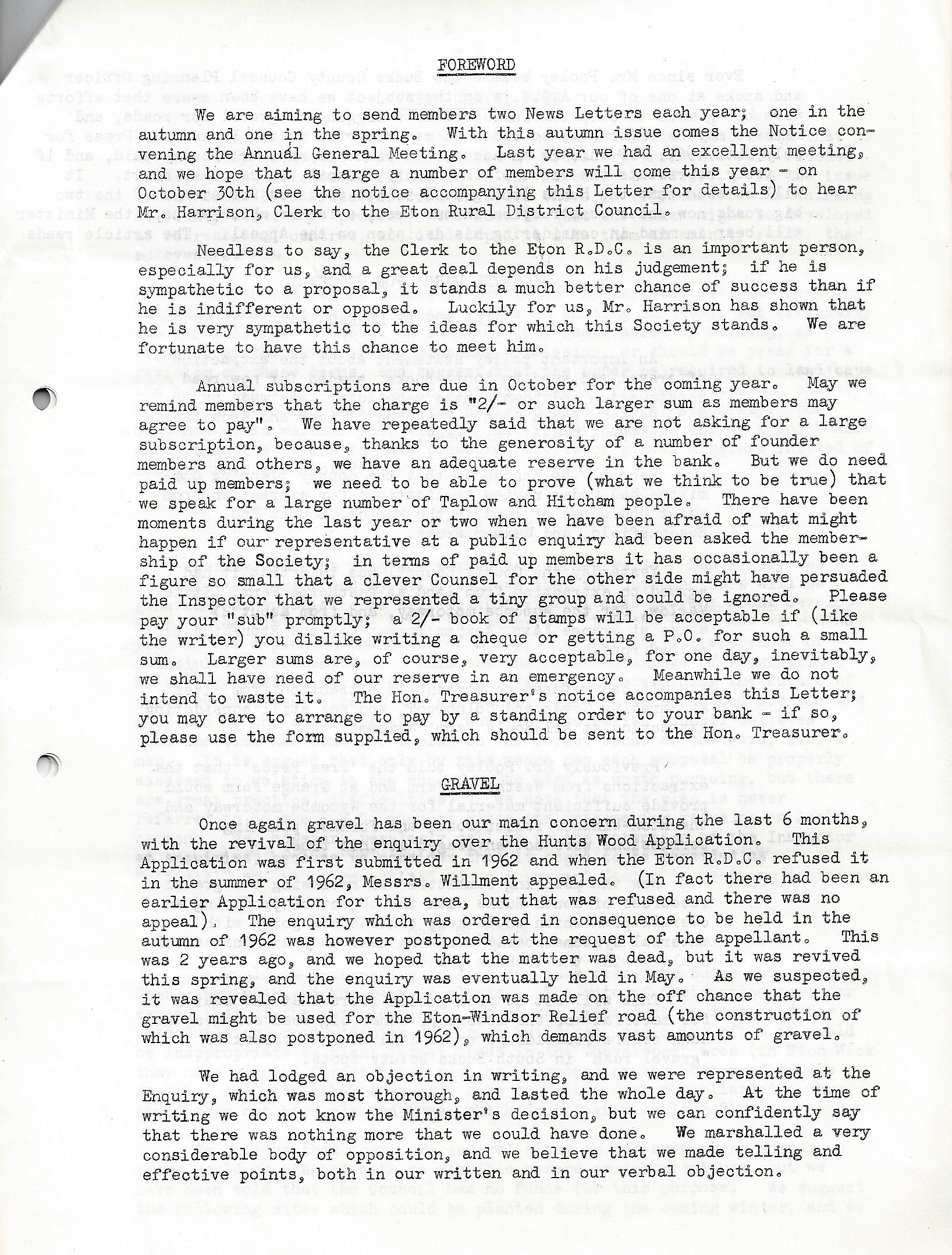
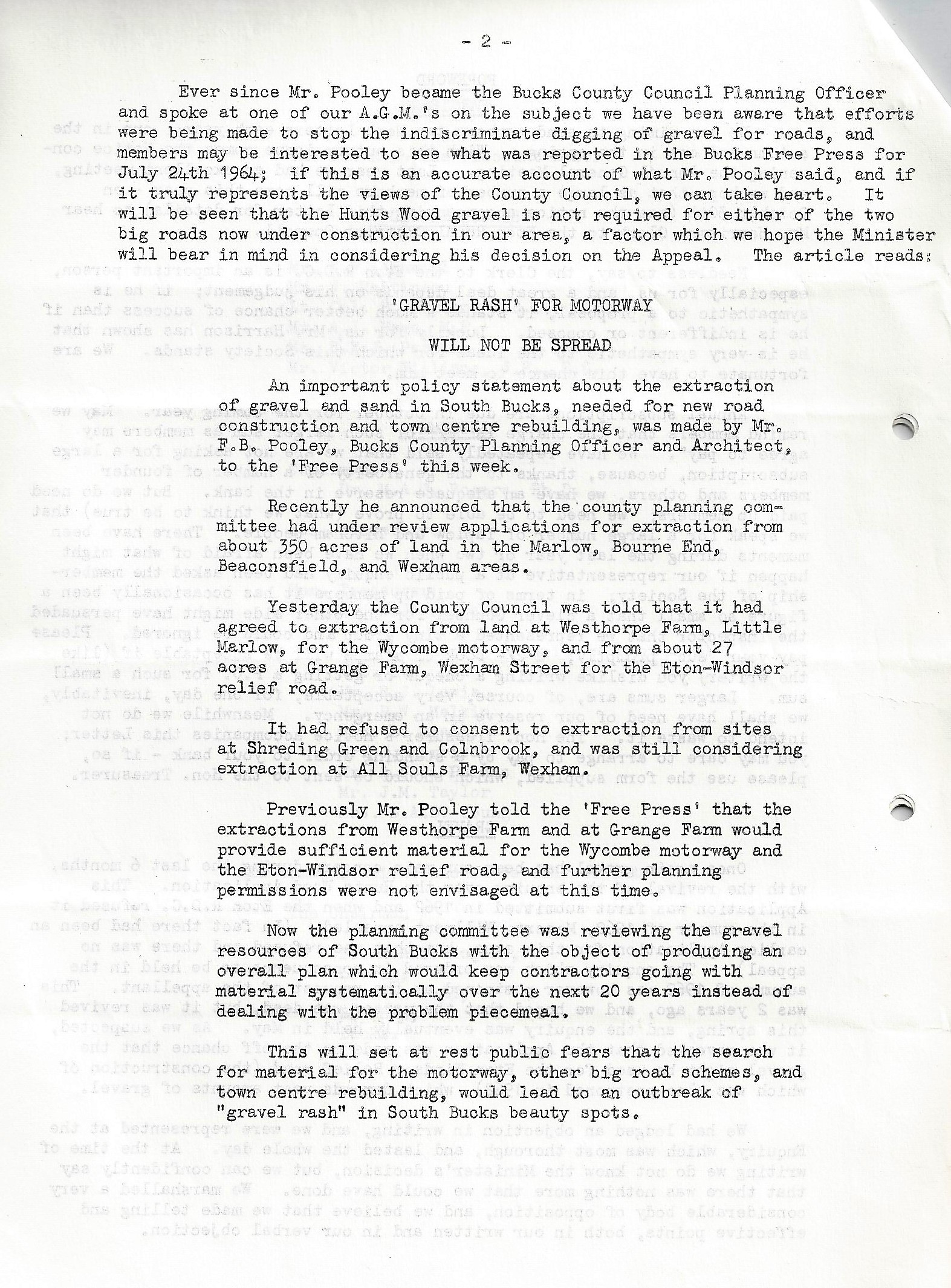
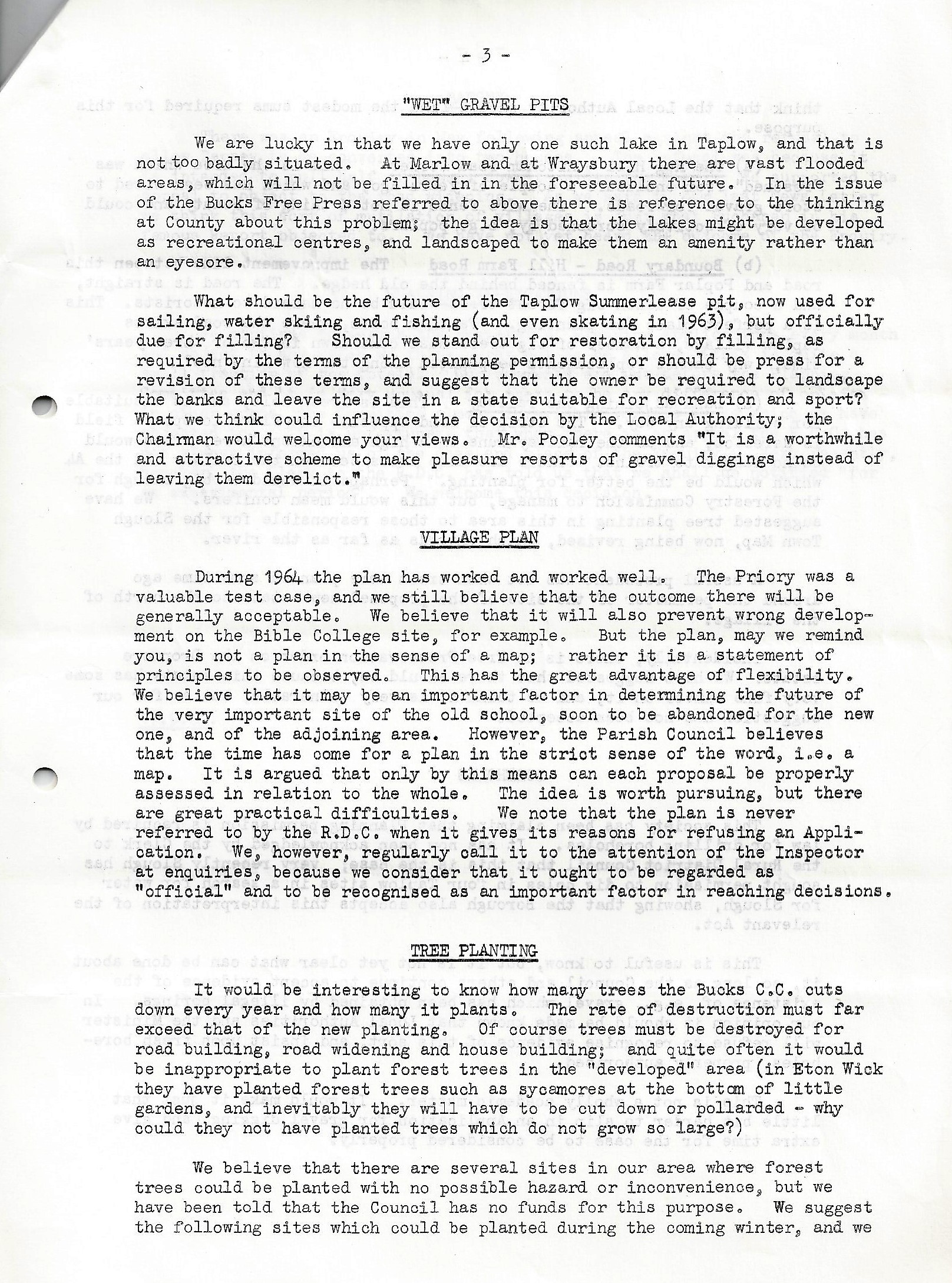
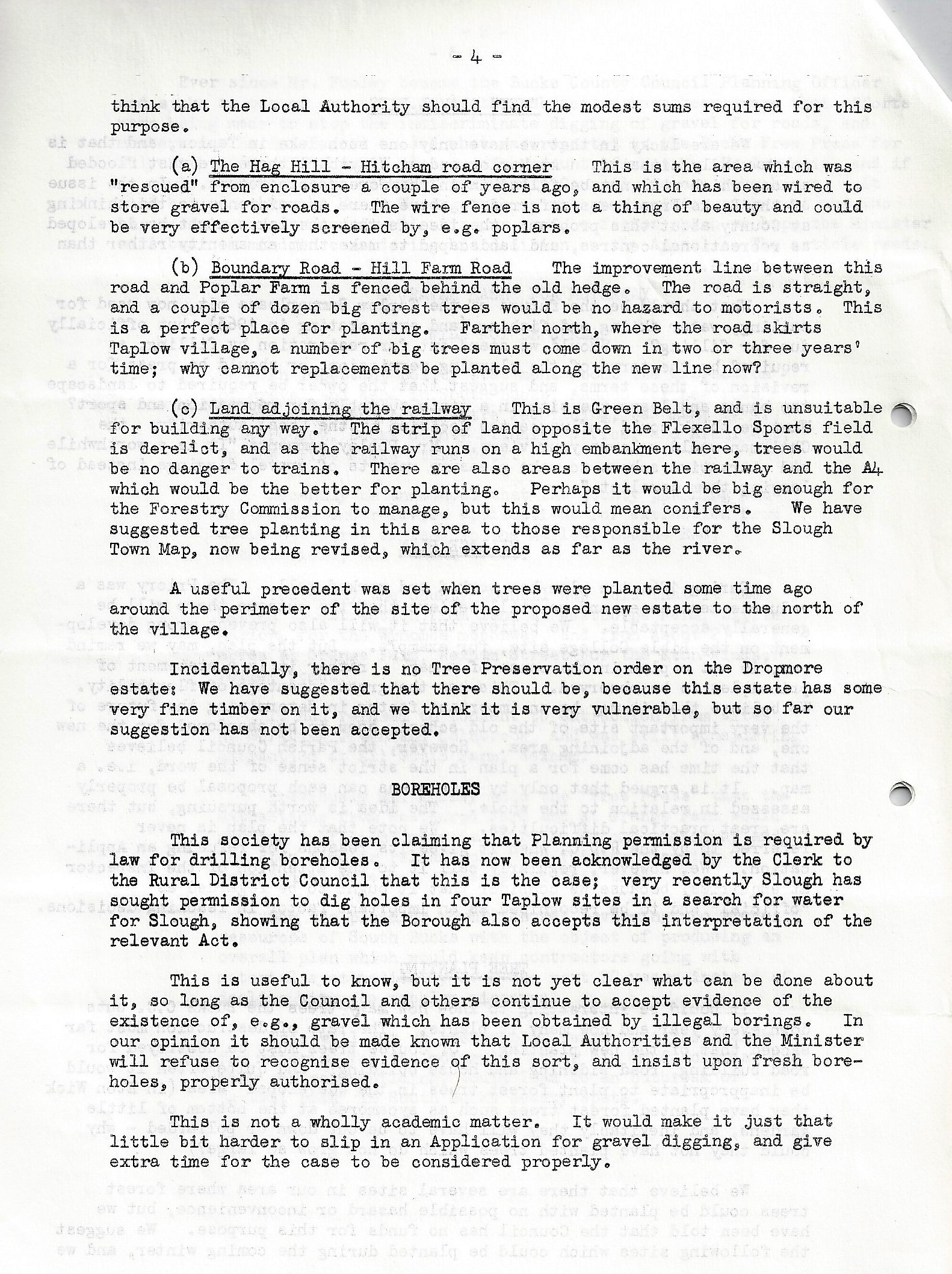
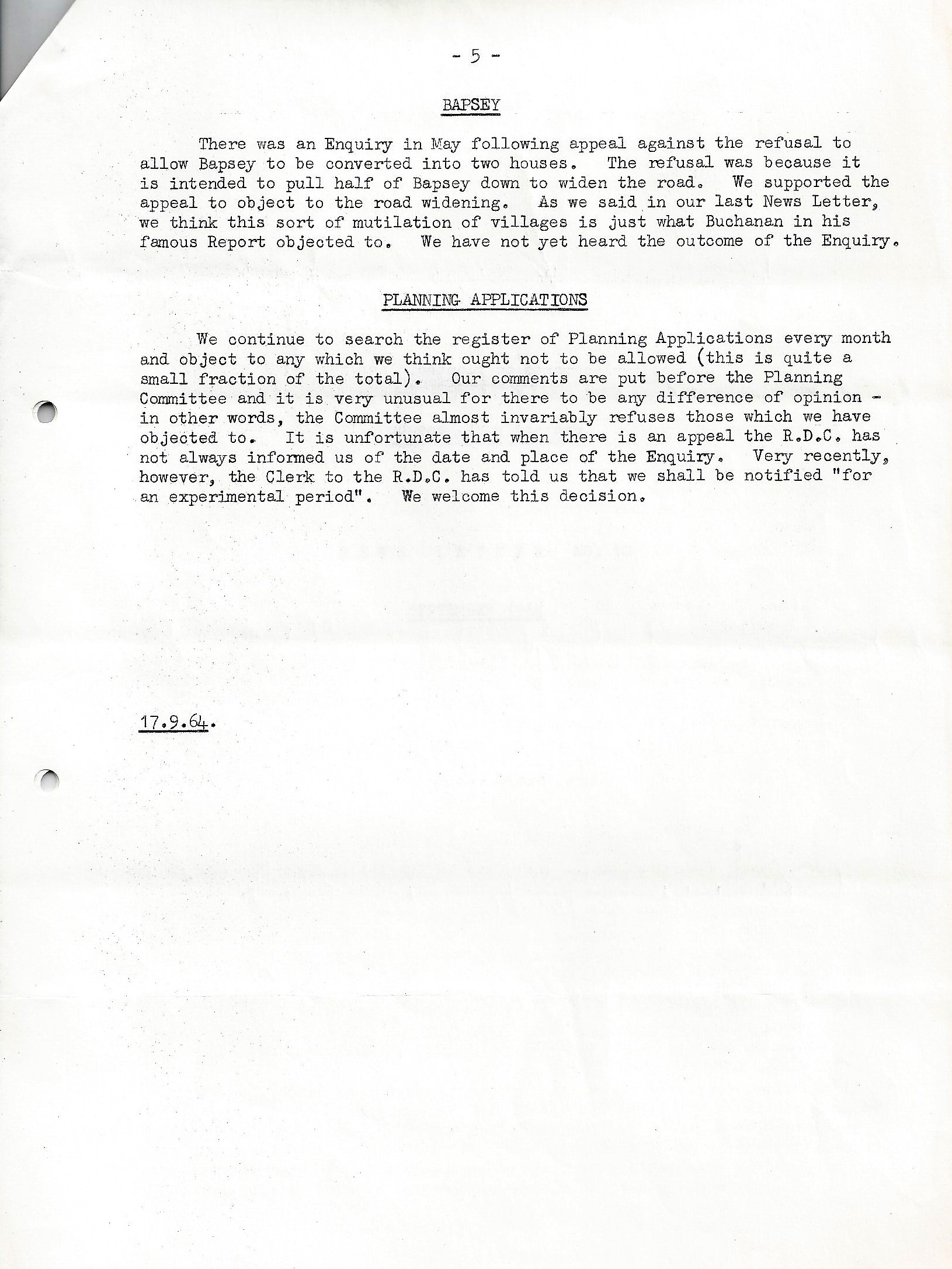
HITCHAM AND TAPLOW
PRESERVATION SOCIETY
NEWS LETTER No. 10
SEPTEMBER 1964
PRESIDENT
The Rt. Hon. The Viscount Astor
VICE-PRESIDENTS
Mr. G.P. Ashwell
Mr. J. Martineau
Lt. Col. B. Morton, 0.B.E., J.P.
Mr. A.J. Page, M.P.
Mr. E.F.J. Perkins
Mr. Victor Williams, J.P., C.C.
COMMITTEE
Chairman:
Dr. M.A.T. Rogers, Ph.D.
Hon. Secretary:
–
Hon. Treasurer:
Mr. W.J. Garrard
Dr. N.W. Hanson (Committee Secretary)
Mrs. E.N. Law
Mr. R.J. Lewis
Mr B.W. Malkin
Mrs. L. Miall
Mr. J.Morrison
Mr. A.J.C. Paines
Mr. J.M. Taylor
Mrs. D.A.D. Young
All communications should be addressed to:—
The Chairman
Dr. M.A.T. Rogers,
Learig,
Hitcham Road,
BURNHAM,
Bucks.
FOREWORD
We are aiming to send members two News Letters each year; one in the autumn and one in the spring. With this autumn issue comes the Notice convening the Annual General Meeting. Last year we had an excellent meeting and we hope that as large a number of members will come this year – on October 30th (see the notice accompanying this Letter for details) to hear Mr. Harrison, Clerk to the Eton Rural District Council.
Needless to say, the Clerk to the Eton R.D.C. is an important person, especially for us, and a great deal depends on his judgement; if he is sympathetic to a proposals it stands a much better chance of success than if he is indifferent or opposed, Luckily for us Mr. Harrison has shown that he is very sympathetic to the ideas for which this Society stands. We are fortunate to have this chance to meet him.
Annual subscriptions are due in October for the coming year. May we remind members that the charge is “2/- or such larger sum as members may agree to pay”, We have repeatedly said that we are not asking for a large subscription, because thanks to the generosity of a number of founder members and others, we have an adequate reserve in the bank. But we do need paid up members; we need to be able to prove (what we think to be true) that we speak for a large number of Taplow and Hitcham people. There have been moments during the last year or two when we have been afraid of what might happen if our representative at a public enquiry had been asked the membership of the Society; in terms of paid up members it has occasionally been a figure so small that a clever Counsel for the other side might have persuaded the Inspector that we represented a tiny group and could be ignored, Please pay your “sub” promptly; a 2/— book of stamps
will be acceptable if (like the writer) you dislike writing a cheque or getting a P.0. for such a small sum. Larger sums are, of course very acceptable, for one day, inevitably, we shall have need of our reserve in an emergency Meanwhile we do not intend to waste it: The Hon. Treasurer’s notice accompanies this Letter; you may care to arrange to pay by a standing order to your bank m if sop please use the form supplied, which should be sent to the Hono Treasurer.
GRAVEL
Once again gravel has been our main concern during the last 6 months, with the revival of the enquiry over the Hunts Wood Application. This Application was first submitted in 1962 and when the Eton R.D.C. refused it in the Sumner of 1962, Messrs. Willment appealed. (In fact there had been an earlier Application for this area, but that was refused and there was no appeal), The enquiry which was ordered in consequence to be held in the autumn of 1962 was however postponed at the request of the appellant. This was 2 years ago, and we hoped that the matter was dead, but it was revived this spring, and the enquiry was eventually held in May. As we suspected it was revealed that the Application was made on the off chance that the gravel might be used for the Eton—Windsor Relief road (the construction of which was also postponed in 1962), which demands vast amounts of gravel.
We had lodged an objection in writings and we were represented at the Enquiry, which was most thorough, and lasted the whole day. At the time of writing we do not know the Minister‘s decision but we can confidently say that there was nothing more that we could have done. We marshalled a very considerable body of opposition, and we believe that we made telling and effective points, both in our written and in our verbal objection.
Ever since Mr. Pooley became the Bucks County Council Planning Officer and spoke at one of our A.G.M.s on the subject we have been aware that efforts were being made to stop the indiscriminate digging of gravel for roads, and members may be interested to see what was reported in the Bucks Free Press for July 24th 1964; if this is an accurate account of what Mr. Pooley said, and if it truly represents the views of the County Council, we can take heart. It will be seen that the Hunts Wood gravel is not required for either of the two big roads now under construction in our area, a factor which we hope the Minister will bear in mind in considering his decision on the Appeal. The article reads:
“GRAVEL RASH” FOR MOTORWAY WILL NOT BE SPREAD
An important policy statement about the extraction of gravel and sand in South Bucks, needed for new road construction and town centre rebuilding, was made by Mr. F.B. Pooley, Bucks County Planning Officer and Architect, to the ‘Free Press’ this week.
Recently he announced that the county planning committee had under review applications for extraction from about 350 acres of land in the Marlow, Bourne End, Beaconsfield, and Wexham areas.
Yesterday the County Council was told that it had agreed to extraction from land at Westhorpe Farm, Little Marlow for the Wycombe motorways and from about 27 acres at Grange Farm, Wexham Street for the Eton—Windsor relief road.
It had refused to consent to extraction from sites at Shreding Green and Colnbrook, and was still considering extraction at All Souls Farm, Wexham.
Previously Mrs Pooley told the ‘Free Press’ that the extractions from Westhorpe Farm and at Grange Farm would provide sufficient material for the Wycombe motorway and the Eton—Windsor relief road, and further planning permissions were not envisaged at this time:
Now the planning committee was reviewing the gravel resources of South Bucks with the object of producing an overall plan which would keep contractors going with material systematically over the next 20 years instead of dealing with the problem piecemeal.
This will, set at rest public fears that the search for material for the motorway, other big road schemes and town centre rebuilding, would lead to an outbreak of “gravel rash” in South Bucks beauty spots.
“WET” GRAVEL FITS
We are lucky in that we have only one such lake in Taplow, and that is not too badly situated. At Marlow and at Wraysbury there are vast flooded areas, which will not be filled in in the foreseeable future. In the issue of the Bucks Free Press referred to above there is reference to the thinking at County about this problem; the idea is that the lakes might be developed as recreational centres, and landscaped to make them an amenity rather than an eyesore.
What should be the future of the Taplow Summerlease pit, now used for sailing, water skiing and fishing (and even skating in 1965): but officially due for filling? Should we stand out for restoration by filling, as required by the terms of the planning permission, or should be press for a revision of these terms, and suggest that the owner be required to landscape the banks and leave the site in a state suitable for recreation and sport? What we think could influence the decision by the Local Authority; the Chairman would welcome your views. Mr. Pooley comments “It is a worthwhile and attractive scheme to make pleasure resorts of gravel diggings instead of leaving them derelict.“
VILLAGE PLAN
During 1964 the plan has worked and worked well, The Priory was a valuable test case, and we still believe that the outcome there will be generally acceptable. We believe that it will also prevent wrong development on the Bible College site, for example. But the plan, may we remind you, is not a plan in the sense of a map; rather it is a statement of principles to be observed. This has the great advantage of flexibility. We believe that it may be an important factor in determining the future of the very important site of the old school, soon to be abandoned for the new one, and of the adjoining area. However, the Parish Council believes that the time has come for a plan in the strict sense of the word, i.e. a map. It is argued that only by this means can each proposal be properly assessed in relation to the whole. The idea is worth pursuing, but there are great practical difficulties. We note that the plan is never referred
to by the R.D.C. when it gives its reasons for refusing an Application. We, however, regularly call it to the attention of the Inspector at enquiries, because we consider that it ought to be regarded as “official” and to be recognised as an important factor in reaching decisions.
TREE PLANTING
It would be interesting to know how many trees the Bucks C.C. cuts down every year and how many it plants. The rate of destruction must far exceed that of the new planting. Of course trees must be destroyed for road building, road widening and house building; and quite often it would be inappropriate to plant forest trees in the “developed” area (in Eton Wick they have planted forest trees such as sycamores at the bottom of little gardens, and inevitably they will have to be cut down or pollarded – why could they not have planted trees which do not grow so large?)
We believe that there are several sites in our area where forest trees could be planted with no possible hazard or inconvenience, but we have been told that the Council has no funds for this purpose. We suggest the following sites which could be planted during the coming winters and we think that the Local Authority should find the modest sums required for this purpose.
(a) The Hag Hill – Hitcham road corner This is the area which was “rescued” from enclosure a couple of years ago, and which has been wired to store gravel for roads. The wire fence is not a thing of beauty and could be very effectively screened by, e.g. poplars.
(b) Boundary; Road – Hill Farm Road The improvement line between this road and Poplar Farm is fenced behind the old hedge. The road is straight, and a couple of dozen big forest trees would be no hazard to motorists. This is a perfect place for planting. Farther north, where the road skirts Taplow village, a number of big trees must come down in two or three years’ time; why cannot replacements be planted along the new line now?
(0) Land adjoining the railway; This is Green Belt, and is unsuitable for building any way. The strip of land opposite the Flexello Sports field is derelict, and as the railway runs on a high embankment here, trees would be no danger to trains. There are also areas between the railway and the A4. which would be the better for planting, Perhaps it would be big enough for the Forestry Commission to manage, but this would mean conifers. We have suggested tree planting in this area to those responsible for the Slough Town Map, now being revised, which extends as far as the river,
A useful precedent was set when trees were planted some time ago around the perimeter of the site of the proposed new estate to the north of the village.
Incidentally, there is no Tree Preservation order on the Dropmore estate. We have suggested that there should be, because this estate has some very fine timber on it, and we think it is very vulnerable, but so far our suggestion has not been accepted.
BOREHOLES
This society has been claiming that Planning permission is required by law for drilling boreholes. It has now been acknowledged by the Clerk to the Rural District Council that this is the case; very recently Slough has sought permission to dig holes in four Taplow sites in a search for water for Slough, showing that the Borough also accepts this interpretation of the relevant Act.
This is useful to know, but it is not yet clear what can be done about it, so long as the Council and others continue to accept evidence of the existence of, e.g. gravel which has been obtained by illegal borings. In our opinion it should be made known that Local Authorities and the Minister will refuse to recognise evidence of this sort, and insist upon fresh bore— holes, properly authorised.
This is not a wholly academic matter. It would make it just that little bit harder to slip in an Application for gravel digging, and give extra time for the case to be considered properly.
BAPSEY
There was an Enquiry in May following appeal against the refusal to allow Bapsey to be converted into two houses. The refusal was because it is intended to pull half of Bapsey down to widen the road, We supported the appeal to object to the road widening. As we said in our last News Letter, we think this sort of mutilation of villages is just what Buchanan in his famous Report objected to, We have not yet heard the outcome of the Enquiry.
PLANNING APPLICATIONS
We continue to Search the register of Planning Applications every month and object to any which we think ought not to be allowed (this is quite a small fraction of the total). Our comments are put before the Planning Committee and it is very unusual for there to be any difference of opinion – in other words, the Committee almost invariably refuses those which we have objected. to. It is unfortunate that when there is an appeal the R.D.C. has not always informed us of the date and place of the Enquiry, Very recently however, the Clerk to the R.D.,C. has told us that we shall be notified “for an experimental period”. We welcome this decision.
17.9.64.